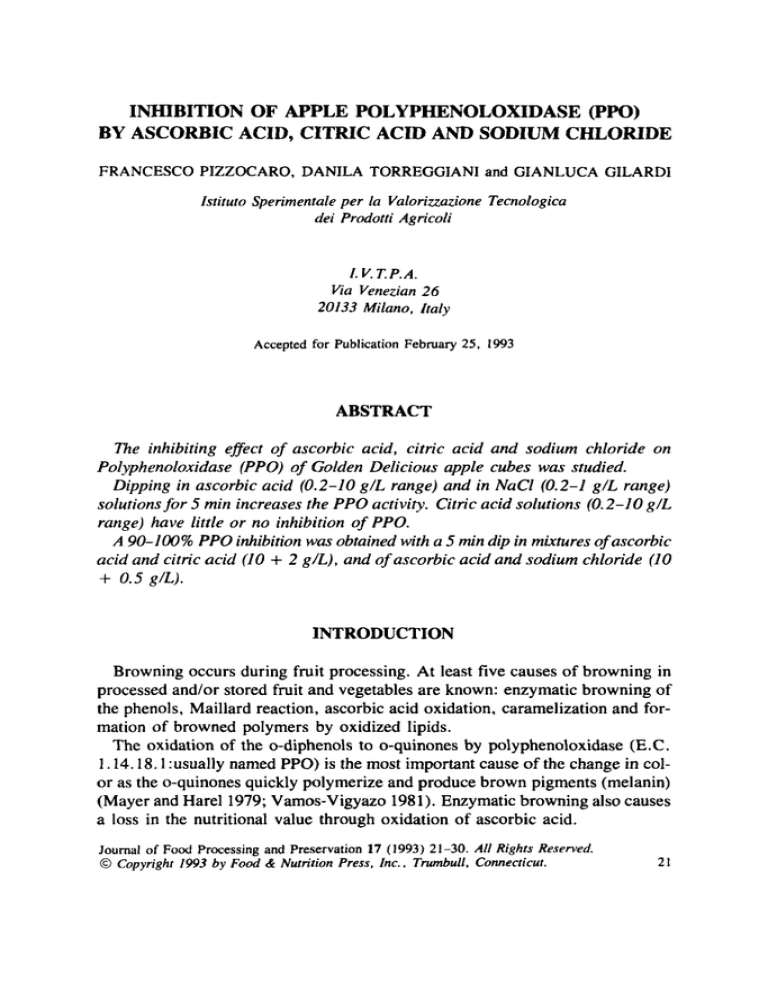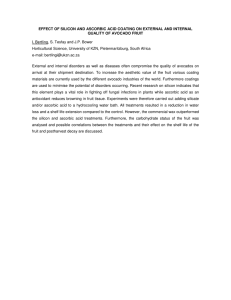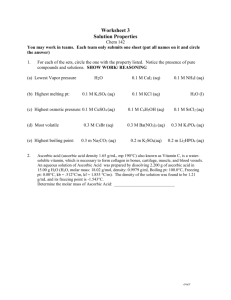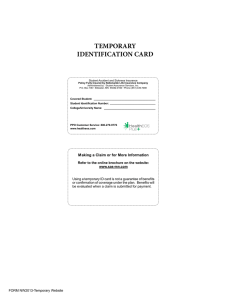
INHIBITION OF APPLE POLYPHENOLOXIDASE (PPO)
BY ASCORBIC ACID, CITRIC ACID AND SODIUM CHLORIDE
FRANCESCO PIZZOCARO, DANILA TORREGGIANI and GIANLUCA GILARDI
Istituto Sperimentale per la Valoriuazione Tecnologica
dei Prodotti Agricoli
I. V. T.P.A .
Via Venezian 26
20133 Milano, Italy
Accepted for Publication February 25, 1993
ABSTRACT
The inhibiting effect of ascorbic acid, citric acid and sodium chloride on
Polyphenoloxidase (PPO) of Golden Delicious apple cubes was studied.
Dipping in ascorbic acid (0.2-10 g/L range) and in NaCl (0.2-1 g/L range)
solutions for 5 min increases the PPO activiry. Citric acid solutions (0.2-10 g / L
range) have little or no inhibition of PPO.
A 90-100% PPO inhibition was obtained with a 5 min dip in mixtures of ascorbic
acid and citric acid (10 + 2 g/L), and of ascorbic acid and sodium chloride (I0
0.5 g/L).
+
INTRODUCTION
Browning occurs during fruit processing. At least five causes of browning in
processed and/or stored fruit and vegetables are known: enzymatic browning of
the phenols, Maillard reaction, ascorbic acid oxidation, caramelization and formation of browned polymers by oxidized lipids.
The oxidation of the o-diphenols to o-quinones by polyphenoloxidase (E.C.
1.14.18.1 :usually named PPO)is the most important cause of the change in color as the o-quinones quickly polymerize and produce brown pigments (melanin)
(Mayer and Hare1 1979; Vamos-Vigyazo 1981). Enzymatic browning also causes
a loss in the nutritional value through oxidation of ascorbic acid.
Journal of Food Processing and Preservation 17 (1993) 21-30. AN Rights Reserved.
0 Copyright 1993 by Food & Nutrition Press, Inc., Tnunbull, Connecticut.
21
22
F. PIZZOCARO. D . TORREGGIANI and G . GILARDI
In the food industry, enzymatic browning can be avoided by using thermal inactivation of PPO, but heat can cause softening.
Instead of blanching, chemical additives can be used to prevent enzymatic
browning: bisulfite (Ponting 1960; Walker 1977; Sayavedra-Sotoand Montgomery
1986), ascorbic acid and its analogs (Bauernfeind and Pinkert 1970; Eskin et al.
1971; Walker 1977; Sapers and Ziolkowski 1987; Hsu et al. 1988), and cysteine
as reducing agent (Walker and Reddish 1964; Montgomery 1983; Dudley and
Hotchkiss 1989).
The chemical action of the bisulfites is to react with the o-quinones forming
colorless complex compounds (Embs and Markakis 1965; Lu Valle 1952; Wedzicha 1984). Ascorbic acid reduces the o-quinones to colorless dihydroxyphenols
(Varoquaux and Sarris 1979; Golan-Goldhirsh and Whitaker 1984).
Although the bisulfites are efficient, they are banned in the USA for use in
raw fruit and vegetables by a ruling of the FDA (1986). The presence of bisulfites
can be dangerous to human health, especially in asthmatic patients (Taylor and
Bush 1986), so alternative chemical additives are needed that are without toxic
effects.
Langdon (1987) showed that different combinations of ascorbic and citric acid
prevent enzymatic browning of sliced potatoes. Santerre et ul. (1988) confirmed
that combinations of ascorbic acid, erythorbic acid and citric acid were efficient
in preventing browning of sliced apples. According to Ponting er al. (1972) sliced
Golden Delicious apples could be protected from browning by using a mixture
of ascorbic acid (0.5%)and calcium chloride (0.05%)at pH 7. De Poix ef d.
(1980), in a study on the action of sodium and calcium chloride on preventing
browning of apple puree, pointed out that the addition of chlorides delays the
occurrence of browning. For a given chloride concentration, the latent period
before the advent of browning is propodonal to the amount of ascorbic acid added.
Sapers and Douglas (1987) showed that the treatment of cut apple surfaces with
1% citric acid monohydrate solutions containing 0.4,0.8, 1.6 or 3.2% ascorbic
acid, is effective in the inhibition of browning.
The phosphate esters of ascorbic acid (ascorbic acid-2-phosphate and ascorbic
acid-2-triphosphate) were investigated as alternative sources to ascorbic acid for
the inhibition of browning at the cut surfaces of raw apples (Sapers et al. 1989).
The phosphate esters were more effective than similar concentrationsof ascorbic
acid in the prevention of browning in Red Delicious and Winesap apples.
Vacuum and pressure infiltration of ascorbic and erythorbic acid into the cut
surfaces of raw apples improved the efficiency of inhibitors (2.25% sodium ascorbate or erythorbate and 0.2% calcium chloride) (Sapers el ul. 1990).
The influence of ascorbic acid on PPO activity is still controversial. Varoquaux
and Sarris (1979) reported that ascorbic acid neither prevented nor activated PPO.
Activation of PPO by ascorbic acid has been reported (Krueger 1950). Golan-
POLYPHENOLOXIDASE INHIBITION IN APPLE CUBES
23
Goldhirsh and Whitaker (1984) showed there was rapid inactivation of the
mushroom PPO incubated with ascorbic acid without the phenolic substrate.
Recently, Hsu ef ul. (1988) reported an inhibiting effect of ascorbic acid on the
PPO of mushrooms.
In the present work the inhibiting effect of ascorbic acid, citric acid and sodium
chloride, used alone or in mixtures, on the apple PPO activity was studied. As
a comparison the PPO inhibition obtained using potassium metabisulfite was also
analyzed.
MATERIALS AND METHODS
Raw Materials
Fresh apples (Mulus domesricu Borkh., cv. Golden Delicious) were obtained
from Valtellina (Italy), picked at commercial maturity and stored at 2 4 2 .
After washing in running water the apples were peeled, cored and mechanically diced (14 mm).
PPO Inhibition
Inhibition of PPO in apple cubes was obtained by:
( I ) Dipping in aqueous solutions of: (a) L (+) ascorbic acid (AA), (b) citric
acid (CA); (c) sodium chloride (NaCI); (d) potassium metabisulfite (PBS). The
reagents were of analytical grade (Merck, Darmstadt, Germany). The concentrations used were: (a) 0.2-1.0-2.0-10.0 g/L of ascorbic acid; (b)
0.2-1 .O-2.0-10.0 g/L of citric acid; (c) 0.2-0.5-1 .O g/L of sodium chloride;
(d) 0.1-0.3-0.5-1 .O g/L of potassium metabisulfite.
(2) Dipping in aqueous solutions of the following mixtures: (a) L (+) ascorbic
acid and citric acid (AA CA); (b) potassium metabisulfite and citric acid (PBS
+ CA); (c) L (+) ascorbic acid and sodium chloride (AA NaCl).
The concentrations of the mixtures were: (a) AA 1 g/L and CA 1 g/L; AA
1 g/L and CA 2 g/L; AA 10 g/L and CA lg/L; AA 10 g/L and CA 2 g/L; (b)
PBS 0.1 g/L and CA 1 g/L; PBS 0.1 g/L and CA 2 g/L; PBS 0.3 g/L and CA
1 g/L; PBS 0.3 g/L and CA 2 g/L; (c) AA 10 g/L and NaCl 0.2 g/L; AA 10
g/L and NaCl 0.5 g/L; AA 10 g/L and NaCl 1 g/L.
The solid/liquid ratio was 1 5 and deionized water at 16-18C was used.
The dipping time was 5 min and the apple cubes were stirred every 30 s with
a plastic spatula. Lengthening the dipping time to 15 min did not significantly
influence the PPO inhibition (data not reported). After dipping, the apple cubes
were left to drip for 2-3 min and kept at 2C prior to analysis. Apple cubes dipped
in deionized water for 5 min, were used as control.
+
+
24
F. PIZZOCARO, D. TORREGGIANI and G. GILARDI
PPO Activity
The apple cubes were immersed in liquid nitrogen and ground immediately in
a stainless steel blender.
A 10 g aliquot of the ground apple was mixed with 10 ml of citric-phosphate
buffer (Mcnvaine) pH 6.5 using a Ultra-Turrax " 2 5 (Janke & Kunkel) homogenizer (20500 rpm) for 60 s. The homogenate was centrifuged (45000 x g) at 4C
for 30 min (Beckman 52-21 centrifuge).
The supernatant was filtered on saturated paper (Schleicher & Schull GmbH,
589) and analyzed for PPO activity at 420 nm and 2%. One milliliter catechol
solution (0.175 M) and 2 ml of citric-phosphate buffer (McIlvaine) pH 6.5 were
added to 0.5 ml of PPO extract (Pifferi and Cultrera 1972). The enzyme activity
was calculated on the basis of the slope of the linear portion of the curve plotted
with AA420 against time (up to 3 and 6 min in untreated and treated samples,
respectively). One unit of enzyme activity was defined as 0.001 AA420 min (mI of extract) - .
'
POLYPHENOLOXIDASE INHIBITION IN APPLE CUBES
TABLE 2.
CITRIC ACID INHIBITION OF APPLE PPO ACTIVITY
n
0
597
33
0.2
624
32
-4.5'
1.n
666
34
-1 1 . 5
2.0
574
27
3.8
in.0
492
20
17.6
............................................
X
= means of 5 r e p l i c a t e s
s . d . = ntAndard d e v i a t i o n
= negat-ive valiies i n d i c a t e PPO a c t i v a t i o n
TABLE 3.
SODIUM CHLORIDE INHIBITION OF APPLE PPO ACTIVITY
................................................
activity
( 0.001
Cone.
(g/L)
X
d.s.
Tnhibition
%
784
1027
31
0.2
46
0
-31
0.5
1480
50
-88
1.n
1483
50
-89
0
X
A A,ZOmi.n-%l-~ )
----------
-
= wan- c.f 5 rr=plicateu
s . d . = utandard d e v i a t i o n
I
= negative valries i n d j m t e PPO a c t i v a t i o n
25
26
F. PIZZOCARO, D. TORREGGIANI and G . GlLARDl
Residual PPO activity was expressed as ratio of treated sample versus its control.
pH was determined according to the AOAC Methods ( 1980).
RESULTS AND DISCUSSION
PPO Inhibition Using Ascorbic Acid, Citric Acid and Sodium Chloride
The inhibition of PPO activity in apple cubes after dipping in ascorbic acid,
potassium metabisulfite, citric acid and sodium chloride solutions is reported in
Table 1, 2 and 3, respectively. When the concentrations of ascorbic acid, citric
acid and sodium chloride in the solutions were increased, the pH of the solutions
and the pH of apple cubes after dipping did not significantly change (data not
reported). Concentrations between 0.2 and 10 g/L of ascorbic acid did not inhibit, but activated PPO. The increase of PPO activity could be due to an insufficient concentration of the ascorbic acid, which at low concentrations might act
as a prooxidant (Kanner er al. 1977; Varnos-Vigyazo 1981).
The inhibition of the PPO was correlated to the amount of potassium
metabisulfite; lg/L completely inhibited PPO activity (Table 1).
Citric acid in concentrations between 0.2 and lOg/Lhad a low inhibiting effeq
and only at the maximum concentration (Table 2). Citric acid is not an antioxidant
agent but its inhibiting effect could be related to the phenolase Cu-chelating power.
Sodium chloride in concentrations between 0.2 and 1 g/l activated PPO (Table
3): lg/Lincreased PPO activity of about 90%. Concentrations between 0.5 and
1 % of sodium chloride had an inhibiting effect on the enzymatic browning of
whole apples or apple pieces (Taufel and Voigt 1964) but only concentrations
of about 20% inactivated PPO isolated from the apple (Ponting and Joslyn 1948).
The inhibitory effect of sodium chloride is attributed to the anion chloride: the
action is of the noncompetitive type, as shown for purified PPO from apples
(Sharon and Mayer 1967; Janovitz-Klapp ef d.1990). The increase of PPO activity observed in this study could be related to conformational changes of the
enzyme or protein association or dissociation due to the modification of the ionic
strength.
PPO Inhibition Using Binary Mixtures
+
(1) Mixtures of L (+)-Ascorbic Acid and Citric Acid (AA CAI. In Table
4 the inhibitory effect of mixtures of ascorbic acid and citric acid on apple PPO
is reported. As a comparison the PPO inhibition obtained using mixtures of
potassium metabisulfite and citric acid (PBS CA) is also reported.
Ascorbic acid and citric acid inhibited PPO activity, and citric acid increased
the inhibiting effect of ascorbic acid. When 2 g/L of citric acid instead of 1 g/L
+
POLYPHENOLOXIDASE INHIBITION IN APPLE CUBES
27
TABLE 4.
ASCORBIC ACID AND CITRIC ACID, A N D POTASSIUM METABISULFITE
A N D CITRIC ACID INHIBITION OF APPLE PPO ACTIVITY
Potassium metahimlfi te
Ascorbic acid
+
Citric acid
+
C i t r i c acid
0
099
3s
0
0
899
35
0
1+1
471
22
47.6
0.1+1
310
18
65.5
l+2
577
25
35.8
0.1+2
304
17
66.2
10+1
573
24
36.3
0.3.1
53
2
94.1
10.2
116
n
87.1
0.3+2
34
2
96.2
X
= means o f 5 I-ep1iri)t.e~
s.d. = s t ~ n d a r ddwiak.ion
were added to 10 g/L of ascorbic acid the PPO inhibition increased from 36.3%
to 87. I %. Citric acid also increased the inhibiting effect of metabisulfite but independelty from the concentration.
+
(2) Mixture of L (+)-Ascorbic Acid and Sodium Chloride (AA NaCI).
The inhibition of PPO using mixtures of ascorbic acid and sodium chloride is
reported in Table 5 . Ten grams/L of ascorbic acid with 0.5 g/L of sodium chloride
completely inhibited the PPO activity. Sodium chloride is more efficient than citric
acid, as by adding 0.5 g/L of NaCl instead of 2 g/L of citric acid to 10 g/L of
ascorbic acid, the PPO inhibition was 100% compared to 87%.
After the treatments using the most efficient mixtures, i.e., ascorbic acid and
citric acid (10 + 2 g/L) and ascorbic acid and sodium chloride (10 + 0.5 g/L),
the pH values of the apple cubes were only slightly lower than the values of the
untreated apples (data not reported). Therefore, in this case, the pH could be
excluded from playing a part in the PPO inhibition.
The explanation of De Poix et al. (1980) of the synergic phenomena between
ascorbic acid and sodium chloride is that the ascorbic acid reduces the quinones
enzymatically formed and delays browning without altering the enzymatic activity, whereas the anion chloride directly inhibits the PPO.
F. PIZZOCARO, D. TORREGGIANI and G. GILARDI
28
In this study PPO activity was increased by ascorbic acid alone (0.2-10 g/L)
or by sodium chloride alone (0.2-1 g/L), on the contrary PPO activity was inhibited by the mixture of ascorbic acid and sodium chloride and the inhibition
was directly related to the concentration of sodium chloride. This suggests that
a more complex mechanism could be involved in the enhancement of the inhibitory
action of ascorbic acid due to sodium chloride.
CONCLUSIONS
A 90-100% inhibition of PPO in apple cubes is obtained by using mixtures
of ascorbic acid and citric acid (10 2 g/L) and ascorbic acid and sodium chloride
0.5 g/L). A similar inhibition is obtainable with 0.5% potassium
(10
metabisulfite or potassium metabisulfite and citric acid (0.3 2 g/L) mixture.
+
+
+
REFERENCES
AOAC. 1980. OfJicialMethods of Analysis, 13th Ed., Association of Official
Analytical Chemists, Washington DC.
BAUERNFEIND, J.C. and PINKERT, D.M.1970. Food processing with added
ascorbic acid. Adv. Food Res. 18, 219.
POLYPHENOLOXIDASE INHIBITION IN APPLE CUBES
29
DE POIX, A., ROUET-MAYER, M.A. and PHILIPPON, J. 1980. Action
combinCe des chlorures et de I’acide ascorbique sur I’inhibition des
brunissements enzymatiques d’un broyat de pommes. Lebensrn. Wiss. Technol.
14, 105.
DUDLEY, E.D. and HOTCHKISS, J.H. 1989. Cysteine as an inhibitor of
polyphenoloxidase. J. Food Biochem. 13, 65.
EMBS, R.J. and MARKAKIS, P. 1965. The mechanism of sulfite inhibition of
browning caused by polyphenol oxidase. J. Food Sci. 30, 753.
ESKIN, N. A.M., HENDERSON, H.M. and TOWSEND, R.J. 197 1 . Browning
reactions in foods. In Biochemisrty of Foods, p. 69, Academic Press, New
York.
FDA. 1986. Chemical preservatives. Food and Drug Admin. Code of Fed. Regulations, Title 21, Part 182, Part 101.
GOLAN-GOLDHIRSH, A. and WHITAKER, J.R. 1984. Effect of ascorbic acid,
sodium bisulfite and thiol compounds on mushroom polyphenol oxidase. J.
Agric. Food Chem. 32, 1003.
HSU, A.F., SHIEH, J.J., BILLS, D.D. and WHITE, K. 1988. Inhibition of
mushroom polyphenoloxidase by ascorbic acid derivatives. J. Food Sci. 53(3),
765.
JANOVITZ-KLAPP, A. H., RICHARD, F.C., GOUPY, P. M. and NICOLAS,
J.J. 1990. Inhibition studies on apple polyphenol oxidase. J. Agric. Food Chem.
38, 926.
KANNER, J., MENDEL, H. and BUDOWSKI, P. 1977. Prooxidant and antioxidant effects of ascorbic acid and metal salts in a 6-carotene-linoleate model
system. J. Food Sci. 42, 60.
KRUEGER, R.C. 1950. The effect of ascorbic acid on the enzymatic oxidation
of monohydric and o-dihydric phenols. J. Amer. Chem. SOC. 72, 5582.
LANGDON, T.T. 1987. Preventing of browning in fresh prepared potatoes
without the use of sulfiting agents. Food Technol. 41(5), 64.
LU VALLE, J.E. 1952. The reaction of quinone and sulfite. J. Amer. Chem.
SOC. 74, 2970.
MAYER, M.A. and HAREL, E. 1979. Review: polyphenol oxidases in plants.
Phytochemistry 18, 193.
MONTGOMERY, M. W. 1983. Cysteine as an inhibitor of browning in pear juice
concentrate. J. Food Sci. 48, 951.
PIFFERI, P. and CULTRERA, R. 1972. Ricerche sulla polifenolossidasi. Nota
1 . Estrazione, parziale purificazione e molteplicith dell’enzima delle ciliegie.
Rivista Sci. Tecnol. Aliment. 2, 93.
PONTING, J.D. 1960. Control of enzymatic browning of fruits. In Food Enzymes, (H.W. Schultz, ed.), Van Nostrand Reinhold/AVI, New York.
F. PIZZOCARO, D. TORREGGIANI and G . GILARDI
30
PONTING, J.D., JACKSON, R. and WATTERS, G. 1972. Refrigerated apple
slices: preservative effects of ascorbic acid, calcium and sulfites. J. Food Sci.
37, 434.
PONTING, J.D. and JOSLYN, M.A. 1948. Ascorbic acid oxidation and browning
in apple tissue extract. Arch. Biochem. 19, 47.
SANTERRE, C.R., CASH, J.N. and VANNORMAN, D.J. 1988. Ascorbic
acid/citric acid combinations in the processing of frozen apple slices. J. Food
Sci. 5.3(6), 1713.
SAPERS, G.M. and DOUGLAS, F.W. Jr. 1987. Measurement of enzymatic
browning at cut surfaces and in juice of raw apple and pear h i t s . J. Food
Sci. 52, 1258.
SAPERS, G.M. et al. 1989. Control of enzymatic browning in apple with ascorbic acid derivatives, polyphenoloxidase inhibitors and complexing agents. J.
Food Sci. 54, 997.
SAPERS, G.M., GARZARELLA, L. and PILIZOTA, V. 1990. Application of
browning inhibitors to cut apple and potato by vacuum and pressure infiltration. J. Food Sci. 55, 1049.
SAPERS, G.M. and ZIOLKOWSKI, M.A. 1987. Comparison of erythorbic and
ascorbic acids as inhibitors of enzymatic browning in apple. J. Food Sci. 52,
1732.
SAYAVEDRA-SOTO, L.A. and MONTGOMERY, M.W. 1986. Inhibition of
polyphenoloxidase by sulfite. J. Food Sci. 51, 1531.
SHARON, M. and MAYER, A.M. 1967. The effect of sodium chloride on
catechol oxidase from apples. Isr. J. Chem. 5, 275.
TAUFEL, K. and VOIGT, T. 1964. Natriumchlorid als inhibitor bei der enzymatischen braunung von apfeln. Nahrung 8, 80.
TAYLOR, S.L. and BUSH, R.K. 1986. Sulfites as food ingredients. Food
Technol. 40(6), 47.
VAMOS-VIGYAZO, L. 1981. Polyphenol oxidase and peroxidase in fruits and
vegetables. CRC Crit. Rev. Food Sci. Nutr. 15(1), 49.
VAROQUAUX, P. and SARRIS, J. 1979. Influence de l’acide ascorbique sur
la cinitique de 1’0-diphinoloxydase(E.C. 1.14.18.1) du champignon de Paris
(Agaricus bisporus). Lebensm. Wiss. Technol. 12, 318.
WALKER, J.R.L. 1977. Enzymatic browning in foods; its chemistry and control. Food Technol. 12, 19.
WALKER, J.R.L. and REDDISH, C.E.S. 1964. Note on the use of cysteine to
prevent browning in apple products. J. Sci. Food Agric. 15, 902.
WEDZICHA, B.L. 1984. Principles, properties and reactions. In Chemistry of
Sulfur Dioxide in Foods, (B.L. Wedzicha, ed.), Elsevier, London.






